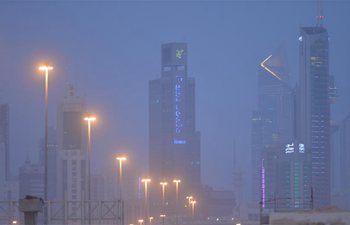by Pankaj Yadav
NEW DELHI, Oct. 21 (Xinhua) -- Winter has slowly begun to approach in north India, and like every year air pollution has once again started posing serious problems in the country's capital and its surrounding areas.
The minimum temperature recorded in Delhi on Sunday morning was 19 degrees Celcius.
There is a direct connect between the advent of winters in north India and rising pollution levels in Delhi, as farmers in neighboring states of Haryana and Punjab indulge in burning the paddy straws and northwest winds reaching the Indian capital bring heavy residues of smoke.
The menace is most likely to get worse in the coming weeks as the festival of Diwali on Oct. 27 is approaching and people will burst crackers despite court strictures against the practice.
On Friday morning, Delhi's overall air quality index (AQI) stood at 306, including 315 at the Delhi Airport. Earlier, on Wednesday, the air quality had plummeted to 307 while it was 270 on Tuesday. New Delhi's air quality index was around 300 on Thursday, classified as "very poor" and meaning prolonged exposure can cause respiratory illness.
At 8:00 on Sunday morning, the AQI in Delhi was docking at 129, which falls in the "moderate" category.
According to the standards, the AQI between the range of 51 to 100 is considered as "satisfactory," 101-200 is "moderate," 201-300 falls under the category of "poor." While 300-400 is considered as "very poor," levels between 401-500 fall under the "hazardous" category.
Major pollutants with particulate matter (PM) 2.5 was detected at 115 in "moderate" category and PM 10 at 221 in "poor" category, in Lodhi Road area earlier Sunday morning, according to the AQI data.
According to System of Air Quality and Weather Forecasting And Research (SAFAR), the stubble burning in Haryana, Punjab and nearby border regions is one of the key causes of air pollution in Delhi and its surrounding areas. These two states are often called the country's bread-baskets as they grow food grains enough to feed the rest of the country.
After harvesting their paddy crops, farmers in these states burn the leftover paddy straws in an easy bid to prepare their fields for the next sowing season. Both, the central and state governments have tried to persuade farmers to desist from this activity, but it goes on unabated.
The farmers were even promised a financial assistance of 200 Indian rupees (approximately 3 U.S. dollars) per quintal of the farm residues usually burnt on the fields.
Only two days ago, activists of the Bhartiya Kisan Union (Indian Farmers Union) burnt the paddy straws in protest against the Punjab state government's failure to compensate the farmers to stop them from burning the farm residue. They also alleged that the paddy straw management machines provided to them were faulty.
Manjit Singh, a local farmers' union leader, was quoted as saying that the state government had failed to provide them with the assistance of 200 Indian rupees per quintal. "We have now asked the farmers to burn the paddy straws without any hesitation. We will continue to set the farm residue ablaze till the government comes with a compensation," he said.
Over 3,200 incidents of burning of farm residues have been recorded in the two states over the past couple of weeks.
According to a senior official at the Central Pollution Control Board (CPCB), around 7 percent air pollution in Delhi is caused due to stubble burning in Haryana and Punjab. Winds blowing from these two states towards the Indian capital carries the deadly smoke along with it, he added.
Activities like construction and demolition of old buildings, garbage dumping in the open and road dust are the other main pollutants of air in Delhi and surrounding areas. Unchecked and illegal constructions, and irresponsible demolitions of old buildings leads to dust and cement particles in the air that further raises the pollution levels.
The Environment Pollution Prevention and Control Authority (EPCA) has warned two coal-based power plants in Haryana's Jhajjar and Panipat districts that they would be shut down if they failed to comply with emission norms next year. According to new norms set to be implemented by December, the power plants are supposed to cut down emissions of particulate matter (PM10), sulphur dioxides (SO2) and oxides of nitrogen.
Once implemented strictly, these norms can help cut particulate matter emission by about 35 percent, oxides of nitrogen emission by about 70 percent, and SO2 emission by more than 85 percent in the next five to seven years, according to the Centre for Science and Environment (CSE), a Delhi-based think tank on environmental issues.
On Friday, the East Delhi Municipal Corporation (EDMC) sprinkled water on the roads in the area around Laxmi Nagar in a bid to reduce dust as a pollution control measure.
A CPCB official proposed a novel idea to curb air pollution. He urged private and government offices in Delhi and the national capital region (NCR) to allow employees to work at home and also encouraged them to carpool or use public transport.
Among other measures already in place to check alarming air pollution levels are curbs on garbage burning in the open, no polluting vehicles on roads, ban on crackers, strict enforcement of dust control norms, fly ash ponds to be watered regularly and complaints registry.













